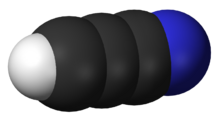Chemistry:Cyanoacetylene
From HandWiki
Short description: Organic compound (HC≡C−C≡N)

| |
| Names | |
|---|---|
| Preferred IUPAC name
Prop-2-ynenitrile | |
| Other names
Propiolonitrile
Cyanoethyne Monocyanoacetylene 2-Propynenitrile | |
| Identifiers | |
3D model (JSmol)
|
|
| ChemSpider | |
PubChem CID
|
|
| UNII | |
| |
| |
| Properties | |
| C3HN | |
| Molar mass | 51.048 g·mol−1 |
| Melting point | 5 °C (41 °F; 278 K) |
| Boiling point | 42.5 °C (108.5 °F; 315.6 K) |
Except where otherwise noted, data are given for materials in their standard state (at 25 °C [77 °F], 100 kPa). | |
| Infobox references | |
Cyanoacetylene is an organic compound with formula C
3HN or H–C≡C–C≡N. It is the simplest cyanopolyyne. Cyanoacetylene has been detected by spectroscopic methods in interstellar clouds,[2] in the coma of comet Hale–Bopp and in the atmosphere of Saturn's moon Titan,[3] where it sometimes forms expansive fog-like clouds.[4]
Cyanoacetylene is one of the molecules that was produced in the Miller–Urey experiment.[5]
- [math]\ce{ H-C#C-H + H-C#N -> H-C#C-C#N + H2 }[/math]
See also
- Dicyanoacetylene, N≡C−C≡C−C≡N
- Diacetylene, H−C≡C−C≡C−H
- Cyanogen, N≡C−C≡N
- Hydrocyanic acid, H−C≡N
- Polyyne, R−(C≡C)n−R
References
- ↑ Murahashi, Shunsuke; Takizawa, Takeo; Kurioka, Shohei; Maekawa, Seiji (1956). "Cyanoacetylene. I. The synthesis and some chemical properties". Nippon Kagaku Zasshi 77 (11): 1689–1692. doi:10.1246/nikkashi1948.77.1689.
- ↑ Solomon, Philip M. (1973). "Interstellar molecules". Physics Today 26 (3): 32–40. doi:10.1063/1.3127983. Bibcode: 1973PhT....26c..32S.
- ↑ H. B. Niemann (2005). "The abundances of constituents of Titan's atmosphere from the GCMS instrument on the Huygens probe". Nature 438 (7069): 779–784. doi:10.1038/nature04122. PMID 16319830. Bibcode: 2005Natur.438..779N. https://deepblue.lib.umich.edu/bitstream/2027.42/62703/1/nature04122.pdf.
- ↑ de Lazaro, Enrico (November 11, 2015). "Cassini Detects Giant Cloud of Frozen Compounds on Saturn's Moon Titan". Sci News. http://www.sci-news.com/space/science-cassini-ice-cloud-saturns-moon-titan-03427.html.
- ↑ Ehrenfreund, P.; Irvine, W.; Becker, L.; Blank, J.; Brucato, J. R.; Colangeli, L.; Derenne, S.; Despois, D. et al. (2002). "Astrophysical and Astrochemical Insights into the Origin of Life". Reports on Progress in Physics 65 (10): 1427–1487. doi:10.1088/0034-4885/65/10/202. Bibcode: 2002RPPh...65.1427E. https://digital.library.unt.edu/ark:/67531/metadc1406361/.
 |


